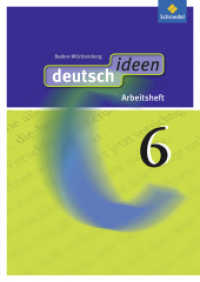- ホーム
- > 洋書
- > 英文書
- > History / World
Full Description
The book students will read: Concise. Relevant. Accessible.
The West: A Narrative History is a concise but not abridged introduction to the West, encompassing all cultures that trace their ancestry to the ancient Mediterranean world. It is not a reduced version of a larger study, but a full narrative of the West written concisely.
This learning program is built around a Key Question in every chapter, a feature that shows students why western civilization is relevant for them. Students will discover the key questions that define the past are in many ways the same key questions of today. Since students often see conflict between a Christian "West" and an Islamic "East" in today's society, the authors highlight the ongoing role the Middle East has played in shaping the West. Students will understand the links between people of the West and those in other regions.
The West is an accessible program available in several formats to give instructors and students more choices and more ways to save. With the release of the 3rd edition, The West becomes an integrated program tied closely to the new MyHistoryLab.
A better teaching and learning experience
This program will provide a better teaching and learning experience-for you and your students. Here's how:
Personalize Learning — The new MyHistoryLab delivers proven results in helping students succeed, provides engaging experiences that personalize learning, and comes from a trusted partner with educational expertise and a deep commitment to helping students and instructors achieve their goals.
Improve Critical Thinking — Each chapter opens with a Key Question and a brief Key Question essay. The Key Question is revisited at the end of the chapter, and MyHistoryLab Icons and Connections features ensure close integration with the new MyHistoryLab.
Engage Students — Maps, illustrations, and a biography feature promote discussion of the narrative.
Support Instructors - MyHistoryLab, Class Preparation Tool, Instructor's Manual, MyTest, Annotated Instructor's eText, and PowerPoints are available to be packaged with this text.
For volume two of this text, search ISBN-10: 0205180914
For the combined volume of this text, search ISBN-10: 0205180957
Note: MyHistoryLab does not come automatically packaged with this text. To purchase MyHistoryLab, please visit: www.myhistorylab.com or you can purchase a ValuePack of the text + MyHistoryLab (at no additional cost): ValuePack ISBN-10: 0205234011 / ValuePack ISBN-13: 9780205234011.
Contents
Found in this section:
1. Brief Table of Contents
2. Full Table of Contents
1. BRIEF TABLE OF CONTENTS
Introduction
Part I Departure Prehistory to 1000 B.C.E.
Chapter 1 The Birth of Civilization
Chapter 2 The Rise of Empires and the Beginning of the Iron Age
Part II The Classical Era 2000 B.C.E. to 30 C.E.
Chapter 3 Aegean Civilizations
Chapter 4 The Hellenic Era
Chapter 5 The Hellenistic Era and the Rise of Rome
Chapter 6 Rome's Empire and the Unification of the Western World
Part III The Division of the West 300 to 1300
Chapter 7 The West's Medieval Civilizations
Chapter 8 The Emergence of Europe
Chapter 9 Europe Turns Outward
Chapter 10 Europe's High Middle Ages
Part IV Challenges, Conflicts, and Departures 1300 to 1700
Chapter 11 Challenges to the Medieval Order
Chapter 12 Renaissance and Exploration
Chapter 13 Reformation, Religious Wars, and National Conflicts
2. FULL TABLE OF CONTENTS
Introduction
Part I — Departure Prehistory to 1000 B.C.E.
Chapter 1: The Birth of Civilization
Key Question: How do environments shape human communities and human communities alter environments?
The Evolution of the Prehistoric Cultures
The Archaic States
The Origin of Civilization in Mesopotamia: Sumer
The Rise of Civilization in Egypt
Chapter 2: The Rise of Empires and the Beginning of the Iron Age
Key Question: Does civilization promote or intensify divisions among peoples?
The Transition States
Imperial Egypt: The New Kingdom
The Indo-Europeans and the Clash of Empires
The Bible and History
Part II — The Classical Era 2000 B.C.E. to 30 C.E.
Chapter 3: Aegean Civilizations
Key Question: When does civilization in the West become "Western" civilization?
Minoan Mentors
The Mycenaeans, Greece's First Civilization
The Aegean Dark Age
The Hellenic Era
The Rise of the Mainland Powers
The Persian Wars: Crucible of a Civilization
Chapter 4: The Hellenic Era
Key Question: What did the Greeks contribute to the development of modern civilization?
Persian Wars as Catalyst
The Peloponnesian War
Intellectual and Artistic Life in the Polis
Chapter 5: The Hellenistic Era and the Rise of Rome
Key Question: What circumstances are likely to undermine governments by the people?
The Hellenistic Era
The Origin of Rome
The Roman Republic
Rome's Civil War
Chapter 6: Rome 's Empire and the Unification of the Western World
Key Question: Do people prefer order to liberty?
The Augustan Era
Order and Continuity: The Dynastic Option
Order and Continuity: The Elective Option
Life in an Imperial Environment
The Decline of Rome
Part III — The Division of the West 300 to 1300
Chapter 7: The West's Medieval Civilizations
Key Question: Should freedom of religion be limited?
The Christian Element
The German Element
The Byzantine Empire of Constantinople
Islam
Chapter 8: The Emergence of Europe
Key Question: How did Europe build on its legacies from the ancient world?
The Merovingian Kingdom: Europe's Nucleus
The Franks' Neighbors
The Carolingian Era
Retrenchment and Reorganization
The Culture of Europe's Dark Age
Chapter 9: Europe Turns Outward
Key Question: Was conflict among the medieval civilizations inevitable?
Islam's Crest and Byzantium's Resurgence
The Reorganization of Feudal Europe
The Eleventh-Century Turning Point
Chapter 10: Europe 's High Middle Ages
Key Question: Why are some societies more open to change than others?
The Renaissance of the Twelfth Century
Universities and Scholasticism
Religious Revival and Diversity of Opinion
The Artistic Vision of the High Middle Ages
Government in the High Middle Ages
Part IV — Challenges, Conflicts, and Departures 1300 to 1700
Chapter 11: Challenges to the Medieval Order
Key Question: What did the crises of the late medieval era reveal about the strengths and weaknesses of Europe's civilization?
Challenges from Nature
Turmoil in the Middle East
Spiritual Crises
Political Responses: The Burdens of War
Chapter 12: Renaissance and Exploration
Key Question: How should a society use its history?
The Context for the Renaissance
The Culture of the Renaissance
The Northern Renaissance
The Middle East: The Ottoman Empire
Europe and Atlantic Exploration
Chapter 13: Reformation, Religious Wars, and National Conflicts
Key Question: How do civilized societies justify war?
The Lutheran Reformation
The Swiss Reformation
The Catholic Reformation
The Habsburg-Valois Wars
England's Ambivalent Reformation
Convergence of Foreign and Domestic Politics: England, Spain, and France
The Final Religious Upheaval







